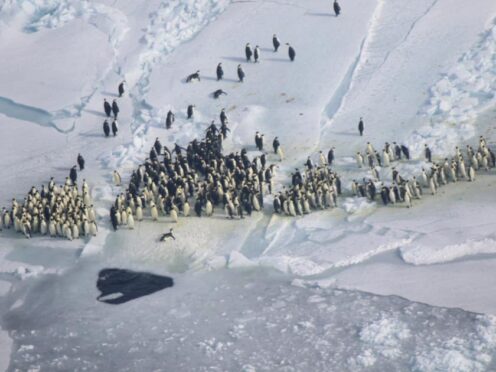Scientists have seen a drop of almost 10% in emperor penguin populations in just under a decade.
A new study from a group of international scientists used very high resolution satellite imagery, alongside field-based surveys and long-term data, to examine the entirety of the penguins’ area range around the Antarctic coast during the springtime.
The research, published in the Proceedings of the Royal Society B journal, has provided the first multi-year time series that documents global population trends.

It comes as emperor penguins have become increasingly difficult to monitor because of their remote locations.
The birds need stable sea ice that is firmly attached to the shore from April through to January to breed, and so warming temperatures put them at high risk.
The loss of sea ice in Antarctica caused unprecedented breeding failure for emperor penguins in 2022, according to the British Antarctic Survey (BAS).
Through the new methodology, the researchers observed 9.6% fewer birds in 2018 compared with in 2009.
The scientists said they cannot yet explain the declining population trend but added that additional research should help to form a better understanding of how causal factors, such as climate change, are having an impact.
They added that the new methodology could also help in the development of adaptive conservation management efforts.

During the course of the study, researchers said they detected several new colonies, bringing the total to 66 known colony locations, adding that it is now highly probable most colony locations have been detected.
Stephanie Jenouvrier, senior author of the article and scientist in the Woods Hole Oceanographic Institution’s Biology Department, said: “What we did in this paper, and through international collaborative research, was to develop the state-of-the-art approach to monitoring emperor penguins across all of Antarctica, including in remote places that are inhospitable to people.
“Having the very high resolution satellite imagery is a breakthrough in our understanding of the spatial distribution of emperor penguins, and having this global population trend is very important for conservation.
“Although we cannot yet clearly attribute this penguin population trend to any particular mechanism such as climate change, there is an accumulation of evidence that the environment is changing and it does not seem to be an environment where penguins are going to endure.”
Philip Trathan, an emeritus fellow with the BAS, where he previously was head of conservation ecology, said: “We don’t understand the population trend in full, and we need to do more research.

“However, the fact that we have detected a population trend in such a short data set is really important because it potentially has major implications for the future of the species.
“Projections indicate that emperor penguins are going to be struggling to survive into the future.
“So, having tools that allow us to ground truth some of the population models in the future will be really important.”
Rod Downie, WWF’s chief polar adviser, said: “It is shocking to learn that in 10 years the global population of adult emperor penguins has declined by 9.6%.
“These icons on ice may well be heading down the slippery slope towards extinction – unless we act now.
“Urgent action is needed to limit average global temperature rise to 1.5C, to protect the waters surrounding Antarctica which are teeming with life, and to designate emperor penguins as specially protected species.”
